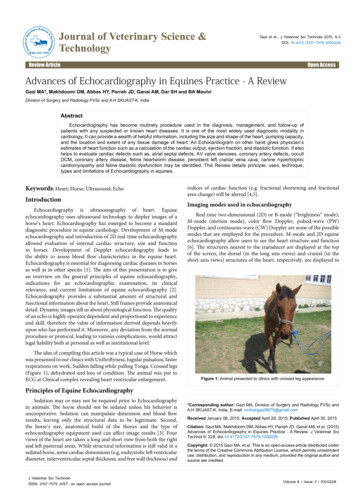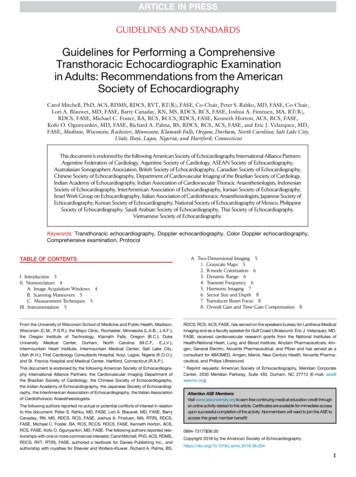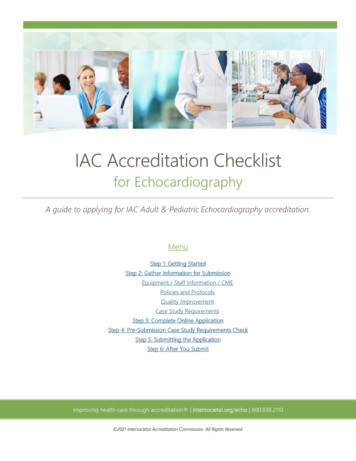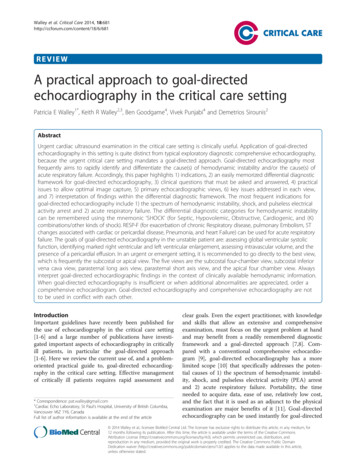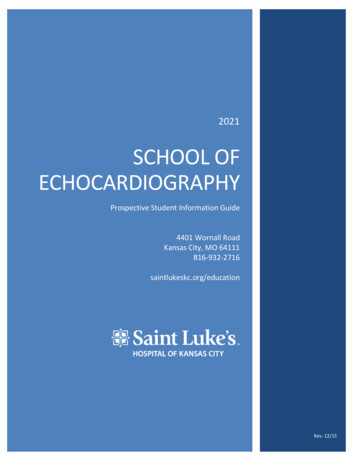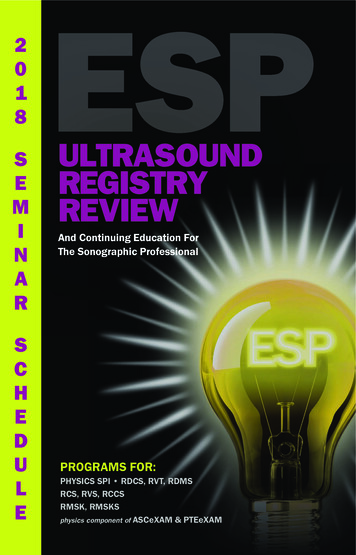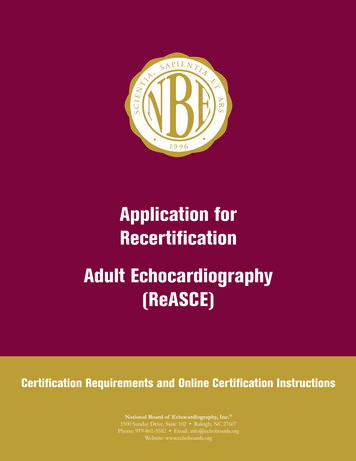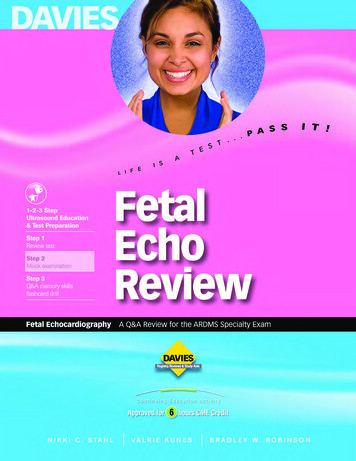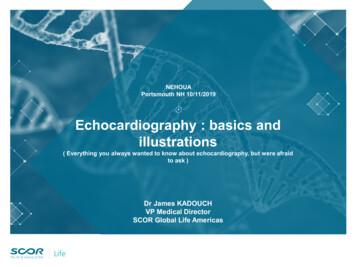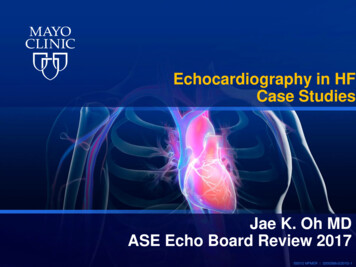
Transcription
Echocardiography in HFCase StudiesJae K. Oh MDASE Echo Board Review 2017 2012 MFMER 3200268v3(2010)-1
Symptoms: Rest or bnormalityDiastolic dysfunctionHigh filling pressureCP1210291-8 2012 MFMER 3200268v3(2010)-2
What, When, and How Often normalityDiastolic dysfunctionHigh filling pressureCP1210291-8 2012 MFMER 3200268v3(2010)-3
“The single most useful diagnostic test in theevaluation of patients with HF is thecomprehensive 2-dimensional echocardiogramcoupled with Doppler flow studies .”C. Yancy et al //index.pdf. 2012 MFMER 3200268v3(2010)-4
Three fundamental questions must be addressed1. Is the LVEF preserved or reduced ?2. Is the structure of the LV normal or abnormal?3. Are there other structural s/failure//index.pdf. 2012 MFMER 3200268v3(2010)-5
Six fundamental questions must be addressed1. Is the LVEF preserved or reduced ?2. Is the structure of the LV normal or abnormal?3. Are there other structural and/orhemodynamic abnormalities ?4. Is diastolic function or filling pressure normalor abnormal ?5. Is strain normal or abnormal ?6. How Echo can help in managing HF ? 2012 MFMER 3200268v3(2010)-6
Echocardiographyfor Heart FailureHeart failure ?LVEF, volume, SVTTE or TEE structure, valve ?NormalAbnormalDiastolic filling ?NonrestrictivePHTPERV iveCHDTissue DopplerE 8E 8ConstrictionMyocardialdiseaseCP1210291-31 2012 MFMER 3200268v3(2010)-7
HF Case #142 year old man with dyspnea Gradual onset of chest tightness and dyspnea Seen in the ED Chest CT negative except for bilateral pleuraleffusion Sent for cardiology evaluation Physical Examination HR 90 BPM, JVP 7 cm Increased S2 intensity with GR 1/6 systolicmurmur Mild pitting edema 2012 MFMER 3200268v3(2010)-8
42 year old man with dyspnea 2012 MFMER 3200268v3(2010)-9
42 year old man with dyspneaWhat is his diastolic function?E 120 A 30 cm/secLat e’ 13 cm/secE/e’ 91. Grade 12. Grade 23. Grade 34. Normal5. ConstrictionMed e’ 10 cm/secE/e’ 12 2012 MFMER 3200268v3(2010)-10
42 year old man with dyspneaLVOT D 2.3 m/secLVOT TVI 26cmSV (2.3)2 x 0.785 x 26 108 mLCO SV x HR 108 x 80 8.6 LCI CO/BSA 8.6 /1.93 4.48 L/m2 2012 MFMER 3200268v3(2010)-11
What is the most common cause of HFseen in this 42 year old man?SV (2.3)2 x 0.785 x 26 108 mLCO SV x HR 108 x 80 8.6 LCI CO/BSA 8.6 /1.93 4.48 L/m21. Shunt2. Obesity3. Liver Disease4. Pheochromocytoma 2012 MFMER 3200268v3(2010)-12
What is PA vascular resistance (PAVR) byEcho measurement?SV (2.3)2 x 0.785 x 26 108 mLCO SV x HR 108 x 80 8.6 LCI CO/BSA 8.6 /1.93 4.48 L/m2TR Velocity 3.2 m/secRVOT TVI 22 cm1 Mildly increased 2 Moderately increased3 Severely increased 4 Normal 2012 MFMER 3200268v3(2010)-13
J Am Coll Cardiol 2003;41:1021–7PVR (TR Vel/ RVOT TVI) x 10 0.16 (3.2/22) x10 0.16 1.42 0.16TR Velocity 3.2 m/secRVOT TVI 22 cm 2011MFMER slide-14 2012 MFMER 3200268v3(2010)-14
RV FunctionTV S’ 20 cm/secTAPSE 25 cm 2012 MFMER 3200268v3(2010)-15
His LVEDD 55, VST 13 and PWT 11mmLV mass index 150 gm/m2What is the type of his LV remodeling?1. Normal2. Concentric remodeling3. Concentric hypertrophy4. Eccentric hypertrophy 2012 MFMER 3200268v3(2010)-16
Relative Wall Thickness (RWT)LV Geometry or Remodeling Type 0.42ConcentricRemodelingConcentricHypertrophyRWT 0.42NormalGeometry 95 ( ) 115 ( )2 x PWTdLVIDdEccentricHypertrophy 95 ( ) 115 ( )RWT 2 x 11 / 55 0.40Left Ventricular Mass Index (g/m2) 2012 MFMER 3200268v3(2010)-17
Normal Global Longitudinal Strain- 19% 2012 MFMER 3200268v3(2010)-18
42 year old man with high output HFBefore and after treatment (Thyrotoxicosis) 2012 MFMER 3200268v3(2010)-19
42 year old man with HFSummaryJACC 2016 CI 4.0 L/m2 Obesity Shunt Liver Disease Diastolic functioncan be normal 2012 MFMER 3200268v3(2010)-20
HF Case #267 year old man with controlledhypertension and treated renal cell ca.presenting with progressive dyspnea. BP 120/80 mmHg HR 8o BPM JVP to the angle of the jaw Clear lung fields S3, but no murmur Hepatomegaly Pitting edema 2012 MFMER 3200268v3(2010)-21
67 year old man with HF 2012 MFMER 3200268v3(2010)-22
67 year old man with HFLVEDD 47 mm PW 18mm IVS 17 mmLV mass index 188 gm/m2Which of following is most liekly correct?1. Normal Athlete’s heart2. Hypertrophic CM3. Concentric hypertrophy with hypertension4. Concentric Infiltration 2012 MFMER 3200268v3(2010)-23
What is his diastolic function?E 100 A 30 cm/sec1. Need more information2. Grade 23. Grade 34. Normal 2012 MFMER 3200268v3(2010)-24
What would you expect for his mitralannulus velocities?1. Medial e’ 4 cm/sec and lateral e’ 6 cm/sec2. Medial e’ 6 cm/sec and lateral e’ 4 cm/sec3. Medial e’ 8 cm/sec and lateral e’ 10 cm/sec4. Medial e’ 10 cm/sec and lateral e’ 8 cm/sec 2012 MFMER 3200268v3(2010)-25
What is his filling pressure?E 100 cm/s A 30 cm/sLat e’ 5 cm/secMedial e’ 4 cm/sec 2012 MFMER 3200268v3(2010)-26
Which of following strain imaging patternsis expected in this patient11234 2012 MFMER 3200268v3(2010)-27
Further study (PYP –SPECT)Transthyretin Cardiac Amyloidosis 2012 MFMER 3200268v3(2010)-28
2012 MFMER 3200268v3(2010)-29
HFpEF by Echo Grade 2-3 at rest E/e’ 15 at rest Abnormal strain Stress Echo Grade 1, ? 2 IndeterminateLancellotti et al. JASE 2017 2012 MFMER 3200268v3(2010)-30
Stages of Heart Failure2013/14 HF GuidelineAAt high riskfor HF W/OSHD orsymptomsBStructuralHeart DiseaseW/O symptomsor signsCDStructuralRefractoryHeart Disease Heart FailureW/ symptomsor signs 2012 MFMER 3200268v3(2010)-31
Distribution of Values of LV Moprhofunctional Parametersfor Stage B Heart Failure CategorizationE/eʹ 13n 40Moderate-to-severe LVHn 123E/eʹ 13n 83E/eʹ 13n 71Strain -18% (n 11)Strain -18% (n 29)Strain -18% (n 11)Strain -18% (n 60)Strain -18% (n 13)Strain -18% (n 58)No or mild LVHn 387E/eʹ 13n 316Strain -49% (n 13)Strain -18% (n 267)Kosmala W et al: JACC 65:257-266, 2015 2012 MFMER 3200268v3(2010)-32
Structural Abnormalities by EchoMyxomaNoncompactionHypertrophic CMPartial Rupture of PMCP1210291-10 2012 MFMER 3200268v3(2010)-33
LV Ejection Fraction/Volume Classification of HF HFrEF HFpEF Prognosis Medical therapy Implantable Cardiac Defibrillator Cardiac Resynchronization Therapy Clinical Trials 2012 MFMER 3200268v3(2010)-34
Dilated or Ischemic CM 2012 MFMER 3200268v3(2010)-35
EchocardiographyHeart Failure with Reduced EF (HFREF) LV Volumes LV Ejection Fraction (EF) Sphericity Filling Pressures Mitral Regurgitation RV Function Pulmonary Artery Systolic Pressure LVAD Structure and Hemodynamics 2012 MFMER 3200268v3(2010)-36
Symptoms: Rest or exerciseEchocardiography in rmalityDiastolic dysfunctionHigh filling pressureCP1210291-11 2012 MFMER 3200268v3(2010)-37
Which of following parameters is mostpredictive of clinical outcome?1. Mitral Regurgitation2. LVED volume index3. Diastolic function4. RV function 2012 MFMER 3200268v3(2010)-38
Survival of Patients with DCMMitral Regurgitation1.00.8Cumulative 800 1,000 1,200 1,400 1,600DaysKoelling et al: Am Heart J 144:527, 2002CP1155462-1 2012 MFMER 3200268v3(2010)-39
Cumulative proportion survivingSurvival of Patients with DCMRV function and Pulmonary HTN1.00.80.60.40.2Group 1 Normal PAP/preserved RVEF (n 73)Group 2 Normal PAP/low RVEF (n 68)Group 3 High PAP/preserved RVEF (n 21)Group 4 High PAP/low RVEF (n 215)0.0-0.2010203040506070MonthsGhio et al: J Am Coll Cardiol 37:183, 2001 2012 MFMER 3200268v3(2010)-40
100BESTLVEDVI 120 mL/m280%60SurvivalPredictors20100 01. LV Volume802. Diastolic FP40%6121824303642DT 150 ms60403. MRLVEDVI 120 mL/m2P 0.0005n 214E 9520100 0P 0.0028n 214E 95612DT 150 ms182430364280%VCW 0.4 cm60P 0.0198n 214E 9540Grayburn et al: JACC45(7):1064, 2005200612VCW 0.4 cm18243036Months post-randomization42CP1188734-3 2012 MFMER 3200268v3(2010)-41
PISA calculation in this patient showedfollowing data: ERO 0.3 cm2 and RV 45mLWhat is MR severity ?1. Mild2. Moderate3. Moderately severe4. Severe 2012 MFMER 3200268v3(2010)-42
Predictors of Clinical Outcome in Ischemic CMSTICH TrialChi-SquareP-valueCreatinine30.0 0.001ESVI (& EF) by echo27.3 0.001Age20.3 0.001Received CABG13.1 0.001E/A ratio by echo12.5 0.0016.00.014MR severity by echoLin et al. In Submission 2012 MFMER 3200268v3(2010)-43
Prognosis in STICH Patients with ICM1511 patients5-year mortality rate (%)1008060E/A 0.6 – 0.8 Best402000.0 0.5 1.0 1.5 2.0 2.5 3.0 3.5 4.0 4.5 5.0 5.5 6.0 6.5 7.0 7.5E/A ratio 2012 MFMER 3200268v3(2010)-44
Echo Guidance: LVAD, Transplant, CRT LVAD Understand LVAD Hemodynamics Cardiac Transplantation Identify signs of rejection Cardiac resynchronization therapy Recognize the role of Echo in CRT 2012 MFMER 3200268v3(2010)-45
LVADHeartmate and Heartware Continuous Flow Impeller and housingabove diaphragm forHM Impeller and housingwithin pericardial sacfor HW Outlet cannula in theascending aorta Hemodynamics aresimilarStainback et al. JASE 2015 2012 MFMER 3200268v3(2010)-46
Which of following conditions becomesworse after LVAD ?1. Aortic stenosis2. Aortic regurgitation3. Mitral stenosis4. Mitral regurgitation 2012 MFMER 3200268v3(2010)-47
Which of following conditions fits best forLVAD?1. LVEF 35%2. LVEDD 63 mm3. Diastolic dysfunction grade 2-34. Mitral regurgitation grade 3-4 2012 MFMER 3200268v3(2010)-48
AV motion in LVAD 2012 MFMER 3200268v3(2010)-49
Advanced HF Therapies: LVAD and TransplantPatient SelectionAdvanced HF EF 25%Optimal medical managementCRT if QRS 120 msec NYHA III-IV 6-minute walk 300 m Peak VO2 14 mL/kg/min Frequent hospital admissionsCMS criteria forDestination TherapyLVADNot eligible for transplantAdvanced HF EF 25% Too old High BMIOptimal medical managementCRT ifHeart transplant/LVAD High PVRQRS 120 msec evaluation Recent malignancy HIV NYHA III-IV Renal insufficiency 6-minutewalk 300m Hepatic insufficiencyEligible for transplant,Eligible for transplant,Betteroutcomeswith LV enlargementdonor available Peak VO2 14 mL/kg/min donor not available Frequent hospital admissions 30 day mortality if LVEDD 63mmHeart transplantLVAD as a bridgeto transplantConsider LVADMiller JACC 2013, Topilsky JACC 2011 2012 MFMER 3200268v3(2010)-50
Stainback et al JASE 2015 2012 MFMER 3200268v3(2010)-51
Role of Pre-operative Assessment forLVAD: Patient Selection High risk for complications Biventricular vs Univentricular support LV size and EF Right ventricular function Shunts (PFO or ASD) Valve disease Intra-cardiac thrombi 2012 MFMER 3200268v3(2010)-52
Pre-LVAD Valve assessmentCourtesy Dr. G LinValvePost-LVADReplace/ RepairConsiderationsAortic regurgitationWorsensContinuousYesRepair or patchclosureAortic stenosisLVAD inflow notaffectedNoNot involved in VADcircuitMitral regurgitationMay improveNo MR due to LV sizeand LVP post-LVADMitral stenosisImpairs LVADinflowYesResults flow toVAD circuitTricuspid regurgitationWorsensYesCould indicate RVdysfunctionYesReplace withbioprosthetic orpatch closureYes, for MSNo, for MR forward flowacross MV post-LVADRisk of thrombosisMechanical Aortic Valve due to flowacross valveMechanical Mitral valveMR improves, MSimpedes flow 2012 MFMER 3200268v3(2010)-53
LVAD Normal ImagesInflow CannulaCourtesy Dr. 2012MFMER 3200268v3(2010)-54Borgeson
LVAD Normal Velocity at Inflow Cannula Velocity influenced byangle of interrogation Velocities are typically 1.5 m/sec Velocities 2 m/s aresuspicious for obstruction(cannula abuts ventricularwall, thrombus) orhypovolemiaCourtesy Dr. 2012MFMER 3200268v3(2010)-55Borgeson
Outflow Cannula Usually into the ascendingthoracic aorta Right parasternal imaging Variable angle of entry, need tomove probe up and downlooking for cannula.(color flow imaging) “Normal” velocity again difficultto define due to angle issues Typically 1.5 but 2 m/secusually abnormal.Courtesy Dr. 2012MFMER 3200268v3(2010)-56Borgeson
2012 MFMER 3200268v3(2010)-57
67 yo male with DCMS/P implantation of Heart Mate II LVADWhich of followings is most likelyexpected?1.2.3.4.Increased FPSevere hypoxemia MR severityLV thrombus 2012 MFMER 3200268v3(2010)-58
TEE in LVAD with too high RPM 2012 MFMER 3200268v3(2010)-59
VAD Abnormalities: Stagnant Flow in Aortic Root 2012 MFMER 3200268v3(2010)-60
VAD Abnormalities: Stagnant Flow in Aortic Root 2012 MFMER 3200268v3(2010)-61
VAD Abnormalities Intracardiac clots 2012 MFMER 3200268v3(2010)-62
Echo for DyssynchronyM mode2-DTissue VelocityColor M mode3-D2-D SpeckleStrain 2011 2012 MFMER 3200268v3(2010)-63
PROSPECTPredictive Value of Echo Dyssynchrony MeasuresImproved Clinical Composite ScoreCut-off criteria met9080Cut-off criteria not metP values0.44 0.026 0.018 0.013 hung et al. Circ 2008 2011CP1290219-13MFMER slide-64 2012 MFMER 3200268v3(2010)-64
Case presentation for CRTApical rocking for postive responseBaselineEDV:231 ml ESV: 177ml EF: 23%1 day after CRTEDV: 207 mlESV: 150 mlEF: 28 % 2011MFMER slide-65 2012 MFMER 3200268v3(2010)-65
Ghani et al EJ CVI 2016 2012 MFMER 3200268v3(2010)-66
Discoordination of LV MechanicsLBBB and Low AVC MVORadial StrainMVC 2011MFMER slide-67 2012 MFMER 3200268v3(2010)-67
JACC HF 2014 2012 MFMER 3200268v3(2010)-68
Echocardiographyfor Heart FailureHeart failure ?LVEF, volume, SVTTE or TEE structure, valve ?NormalAbnormalDiastolic filling ?NonrestrictivePHTPERV iveCHDTissue DopplerE 8E 8ConstrictionMyocardialdiseaseCP1210291-31 2012 MFMER 3200268v3(2010)-69
Thank You!Oh.jae@mayo.edu 2012 MFMER 3200268v3(2010)-70
Echocardiography in HF Case Studies Jae K. Oh MD ASE Echo Board Review 2017 2012 MFMER 3200268v3(2010)-2 CP1210291-8 Heart failure Symptoms: Rest or exercise Diastolic dysfunction High filling pressure Systolic dysfunction S

